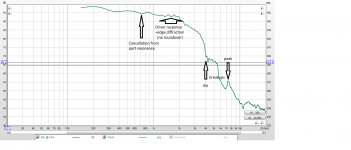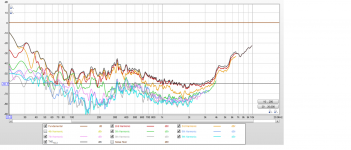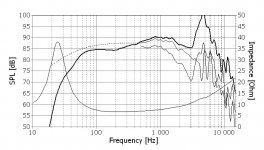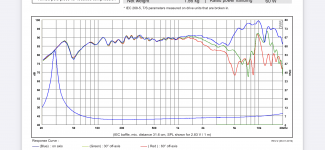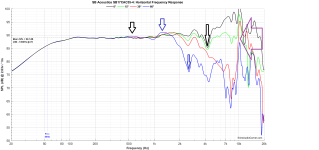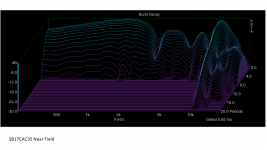I've always wondered about how far I should drive breakups.
Some say 20dB is enough, others say 30dB, others go for 40dB or more.
after the driver (eg. Tweeter) overlaps, how much does masking affect the ability to hear these breakups?
Here's my driver + LP filter. Measurement conditions 0.5m, on baffle. Equivalent to 90dB/1m.
Are my breakups adequately suppressed? Perhaps this is one of those things where I need to test empirically with a DSP...
Some say 20dB is enough, others say 30dB, others go for 40dB or more.
after the driver (eg. Tweeter) overlaps, how much does masking affect the ability to hear these breakups?
Here's my driver + LP filter. Measurement conditions 0.5m, on baffle. Equivalent to 90dB/1m.
Are my breakups adequately suppressed? Perhaps this is one of those things where I need to test empirically with a DSP...
Attachments
Last edited:
I would say that depends on how nasty the breakup is. If it is a paper cone with a fairly benign breakup then I wouldn't worry that much. If it is a metal cone and a bit more nasty then 30 dB or thereabout should be fine.
Linkwitz crossed the 8" metal cone woofer in the Orion @1400 LR4, breakup at ~ 5000 hz so roughly 30 dB supressed and that breakup is quite nasty. See image taken from E0022-08S W22EX001.
Your breakup is a tiny 4 dB bump, I wouldn't loose any sleep over it even if I crossed the driver an octave higher. I would worry more about matching the off axis response of the tweeter.
Linkwitz crossed the 8" metal cone woofer in the Orion @1400 LR4, breakup at ~ 5000 hz so roughly 30 dB supressed and that breakup is quite nasty. See image taken from E0022-08S W22EX001.
Your breakup is a tiny 4 dB bump, I wouldn't loose any sleep over it even if I crossed the driver an octave higher. I would worry more about matching the off axis response of the tweeter.
Attachments
Last edited:
Great!
Thanks for your reply. I achieved that response with 2 components. Won’t waste any more for a notch filter.
I’ll focus my energy on balancing out the level of baffle step compensation and SPL and phase response for the octave below and above Fc to the tweeter, to get the tonal balance right.
Thanks for your reply. I achieved that response with 2 components. Won’t waste any more for a notch filter.
I’ll focus my energy on balancing out the level of baffle step compensation and SPL and phase response for the octave below and above Fc to the tweeter, to get the tonal balance right.
Last edited:
FWIW, in prosound they consider > -25 dB is sufficient, but we have a +/- 40 dB mid-band hearing 'envelope', so at home I imagine those with especially keen hearing may not agree; for instance there was one woman that couldn't tolerate FM unless the 8+ kHz was shelved down to whatever the dbx EQ minimum was and even then at very SPLs.
-25dB is good. I'd say that for the whole range which in the above example starts at 3k (or possibly before, as the measurements are kind of sparse making it difficult to see the signs).
Hi Rabbitz,
No, this the Purifi "proprietary fibre mix"
Hi Allen,
Can you elaborate on what you mean by sparse?
I wonder then how a “breakup” is defined.
Here’s is example of an ceramic coated aluminum driver; taken from
SB Acoustics datasheet: (2019)
Ref: https://sbacoustics.com/wp-content/uploads/2020/02/6in-SB17CAC35-4.pdf
Here is a measurement from Erin’s Audio corner.
SB Acoustics SB17CAC35-4 6 Inch Ceramic Midwoofer Review
He’s measuring with a “Klippel’s Transfer Function Measurement module in conjunction with Klippel’s In-Situ Compensation module” which gives him a resolution of 20Hz increments.
Where could one say the breakup is starting? From would you say it's 4Khz? (major peak for the on-axis) or 5Khz (major dip in the off axis)
From Erin's is it ~2.6Khz? Or is it earlier, when the off axis measurements show an increased SPL.
This might be picking nits, but I do want to understand better. I go a generally smooth and flat response, but I won't try to iron out all the small lumps and bumps.
No, this the Purifi "proprietary fibre mix"

Hi Allen,
Can you elaborate on what you mean by sparse?
I wonder then how a “breakup” is defined.
Here’s is example of an ceramic coated aluminum driver; taken from
SB Acoustics datasheet: (2019)
Ref: https://sbacoustics.com/wp-content/uploads/2020/02/6in-SB17CAC35-4.pdf
Here is a measurement from Erin’s Audio corner.
SB Acoustics SB17CAC35-4 6 Inch Ceramic Midwoofer Review
He’s measuring with a “Klippel’s Transfer Function Measurement module in conjunction with Klippel’s In-Situ Compensation module” which gives him a resolution of 20Hz increments.
Where could one say the breakup is starting? From would you say it's 4Khz? (major peak for the on-axis) or 5Khz (major dip in the off axis)
From Erin's is it ~2.6Khz? Or is it earlier, when the off axis measurements show an increased SPL.
This might be picking nits, but I do want to understand better. I go a generally smooth and flat response, but I won't try to iron out all the small lumps and bumps.
Attachments
Last edited:
Hmmm... think I just learnt a bit more whilst trying to figure it out. An oldie but a goodie:
Linear distortion
Linear distortion
While breakup is a linear distortion, it's a different kind so don't get too wrapped up in that description. The peak can simply be EQed. Except that breakup is about the cone bending. You could fix it on axis but it will only be wrong elsewhere.
Looking at the angles helps to see it. Plots with only 3 angles can hide details.Can you elaborate on what you mean by sparse?
Looked a similar profile I was getting with a SB17NAC with an xo and particularly the 7kHz peak.
Audibility of those peaks when attenuated, especially if they are narrow, can be harder but when you recognize them for the first time in a loudspeaker, you can not unhear them anymore.
That's why insist that, in my own designs, breakup resonances sink to at least -40dB, which is a realm of harmonic distortion.
Logic behind it is, we are obsessing when harmonic distortion is 1% (-40dB) but there are resonances at -20dB or -30dB.
That's why insist that, in my own designs, breakup resonances sink to at least -40dB, which is a realm of harmonic distortion.
Logic behind it is, we are obsessing when harmonic distortion is 1% (-40dB) but there are resonances at -20dB or -30dB.
Last edited:
If you look at the frequency response versus time, such as by using cumulative spectral decay or waterfall, there will be a peak that lasts longer than the other frequencies around it. There will also be an abnormal spike in the group delay and phase at that frequency. That is energy storage, indicative of the breakup you are trying to find. Based on your first two images it doesn’t look like anything to worry about, but a CSD plot might reveal a ringing problem. You can also identify ringing at high frequencies, where applicable, in an impulse response plot....Where could one say the breakup is starting? From would you say it's 4Khz? (major peak for the on-axis) or 5Khz (major dip in the off axis)...
I just happened to be making some measurements yesterday of my SB17CAC35-4 driver.
This burst decay measurement (ARTA) was made in the near field, so there are cancellation nulls at 2.6k, 5.2k, and 8k. However, it is clear there is no resonant behavior below 8k. There is no energy storage. The first cone resonance is at 10k, and it takes about 18 cycles for that resonance to decay down to -30 dB.
The off-axis behavior highlighted in post #7 by tktran303 are something other than cone diaphragm resonance. My guess is that the rubber surround is moving in anti-phase and the effect is amplified off-axis. The resonance of the rubber surround would be very low Q, very highly damped, so it would not show up in CSD or burst decay plots.
j.
This burst decay measurement (ARTA) was made in the near field, so there are cancellation nulls at 2.6k, 5.2k, and 8k. However, it is clear there is no resonant behavior below 8k. There is no energy storage. The first cone resonance is at 10k, and it takes about 18 cycles for that resonance to decay down to -30 dB.
The off-axis behavior highlighted in post #7 by tktran303 are something other than cone diaphragm resonance. My guess is that the rubber surround is moving in anti-phase and the effect is amplified off-axis. The resonance of the rubber surround would be very low Q, very highly damped, so it would not show up in CSD or burst decay plots.
j.
Attachments
I go by this mantra:
-25dB minimum from nominal sensitivity level is the bare minimum. Sometimes you can't do better.
-40dB is considered to be better and borderline inaudible, and as Zvu stated, into the HD levels.
-50dB is considered critically damped, and no longer an issue of any kind.
Wolf
-25dB minimum from nominal sensitivity level is the bare minimum. Sometimes you can't do better.
-40dB is considered to be better and borderline inaudible, and as Zvu stated, into the HD levels.
-50dB is considered critically damped, and no longer an issue of any kind.
Wolf
Hmmm... think I just learnt a bit more whilst trying to figure it out. An oldie but a goodie:
Linear distortion
Good paper, thx.
I go by this mantra:
-25dB minimum from nominal sensitivity level is the bare minimum. Sometimes you can't do better.
-40dB is considered to be better and borderline inaudible, and as Zvu stated, into the HD levels.
-50dB is considered critically damped, and no longer an issue of any kind.
Wolf
I completely agree. Running a high Q breakup in the passband of the filter and trying to fix it with EQ is very audible and pointless. The decay spectrum will still show resonance and you won't be able to hide that, especially with instruments like piano.
I would consider anything less than 40 dB suppression insufficient for critical audio reproduction. Its even worse when the breakup peak is in the 3 - 6 kHz range, where your ears are the most sensitive. In that range, you can hear less than 0.5 % 3rd order HD.
Rabbitz;
How far down did you take it down until it wasn’t audible?
Hi tktran303
I found 20dB down suited my needs and barely shows up in the summed response and I can't hear it. Probably swamped by the other frequencies as it's only a small peak that's a fraction of an octave. I tried xo's which pushed it down further but the sonics suffered.
I did read somewhere that 18dB down is a good starting point for nasties.
FWIW, in passive speakers I'll tend to put an LC filter across the driver to present a short-circuit to the crossover (and driver). The result is lots of attenuation (in theory, the DCR of the inductor is the limiting factor) and lots of electrical damping for the driver.
Chris
Chris
While breakup is a linear distortion, it's a different kind so don't get too wrapped up in that description.
But doesn't breakup generate double and triple etc. frequencies of the signal? Some parts of the cone vibrate at double, triple etc. frequencies. That's plain non-linear harmonic distortion?
Jan
- Home
- Loudspeakers
- Multi-Way
- Breakups are the hardest thing to do!?
